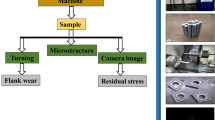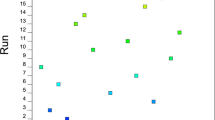Abstract
In the multi-axis machining of freeform surface, compared with ball end mill, the fillet end mill has higher machining efficiency under the same residual height and has been widely used. As the most important physical quantity in machining process, milling force has always been the focus of research. In this paper, the contact geometry between fillet end mill and freeform surface is analyzed by analytical method, and then the milling force prediction model of multi-axis machining is established. Based on differential discretization, the cutter location point of multi-axis machining of freeform surface is approximate to multi-axis machining of oblique plane, which simplifies the research object. The inclination angle is defined to describe the relationship among cutter axis, feed, and workpiece in cutter coordinate system. The space range of the cutting edge element participating in material cutting is constructed by the swept surface of previous tool path, the to-be machined surface and the feed direction surface, and the in-cut cutting edge is determined by judging the cutting edge element one by one. Considering cutter run-out, the element cutting forces on the cylindrical and fillet surfaces of fillet end mill are derived, and all the element forces within in-cut cutting edge are summed by vector to obtain the overall milling force of fillet end mill. Simulation results show that, compared with the solid method, this contact analysis method between cutter and workpiece can take both efficiency and accuracy into account. In the machining experiment, the measured force and predicted force are consistent in trend and amplitude, which verifies the effectiveness of the milling force prediction model.













Similar content being viewed by others
Data availability
The datasets used in our study are available from the corresponding author on reasonable request.
References
Spence AD, Altintas Y (2000) A Solid modeller based milling process simulation and planning system. J Eng Ind Trans ASME 116(1):61
Ju GG, Song QH, Liu ZQ, Shi JH, Wan Y (2015) A solid-analytical-based method for extracting cutter-workpiece engagement in sculptured surface milling. Int J Adv Manuf Technol 80(5-8):1297–1310
Ferry W, Yip-Hoi D (2008) Cutter-workpiece engagement calculations by parallel slicing for five-axis flank milling of jet engine impellers. J Manuf Sci Eng 130(5):383–392
Aras E, Feng HY (2011) Vector model-based workpiece update in multi-axis milling by moving surface of revolution. Int J Adv Manuf Technol 52(9-12):913–927
Wei ZC, Wang MJ, Cai YJ, Wang SF (2013) Prediction of cutting force in ball-end milling of sculptured surface using improved Z-map. Int J Adv Manuf Technol 68(5-8):1167–1177
Kiswanto G, Hendriko H, Duc E (2015) A hybrid analytical- and discrete-based methodology for determining cutter-workpiece engagement in five-axis milling. Int J Adv Manuf Technol 80(9-12):2083–2096
Kiswanto G, Hendriko H, Duc E (2014) An analytical method for obtaining cutter workpiece engagement during a semi-finish in five-axis milling. Comput Aided Des 55:81–93
Sun Y, Guo Q (2011) Numerical simulation and prediction of cutting forces in five-axis milling processes with cutter run-out. Int J Mach Tools Manuf 51(10-11):806–815
Guo ML, Wei ZC, Wang MJ, Li SQ, Liu SX (2018) Force prediction model for five-axis flat end milling of free-form surface based on analytical CWE. Int J Adv Manuf Technol 99:1023–1036
Zhang Z, Li H, Meng G, Song R, Zhou J (2017) A new procedure for the prediction of the cutting forces in peripheral milling. Int J Adv Manuf Technol 89(5-8):1709–1715
Wang L, Si H, Guan L, Liu Z (2018) Comparison of different polynomial functions for predicting cutting coefficients in the milling process. Int J Adv Manuf Technol 94(5-8):2961–2972
Wei ZC (2011) prediction of milling force and yield error in curved surface machining with ball end milling cutter. Dalian University of technology, Dalian
Dikshit MK, Puri AB, Maity A (2016) Analysis of rotational speed variations on cutting force coefficients in high-speed ball end milling. J Braz Soc Mech Sci Eng 39:3529–3539
Guo ML, Wei ZC, Wang MJ, Li SQ, Liu SX (2018) An identification model of cutting force coefficients for five-axis ball-end milling. Int J Adv Manuf Technol 99:937–949
Altintas Y (2000) Manufacturing automation: metal cutting mechanics, machine tool vibrations, and CNC design. Cambridge University Press, Cambridge
Lee P, Altintas Y (1996) Prediction of ball-end milling forces from orthogonal cutting data. Int J Mach Tools Manuf 36(9):1059–1072
Ozturk E, Budak E (2007) Modeling of 5-axis milling processes. Mach Sci Technol 11(3):287–311
Kline WA, DeVor RE (1983) The effect of runout on cutting geometry and forces in end milling. Intl J Mach Tool Des Res 23:123–140
Wei ZC, Li SQ, Guo ML, Wang J, Liu SX (2019) Plane surface milling force prediction with fillet end milling cutter under pre-determined inclination angle. Int J Adv Manuf Technol 103:2849–2864
Wan M, Zhang WH, Tan G, Qin GH (2007) New algorithm for calibration of instantaneous cutting-force coefficients and radial run-out parameters in flat end milling. Proc Inst Mech Eng B J Eng Manuf 221(6):1007–1019
Funding
This research is supported by the National Key R&D Program of China No. 2019YFA0705304 and the National Natural Science Foundation of China No. 52005078 and the National Natural Science Foundation of China No. 52075076
Author information
Authors and Affiliations
Contributions
All the authors contributed significantly to the work with the order provided.
Corresponding author
Ethics declarations
Ethical approval
Not applicable.
Consent to participate
Not applicable.
Consent to publish
All the authors have reached agreement for publication.
Competing interests
The authors declare no competing interests.
Additional information
Publisher’s note
Springer Nature remains neutral with regard to jurisdictional claims in published maps and institutional affiliations.
Rights and permissions
About this article
Cite this article
Guo, M., Wei, Z., Li, S. et al. Force model of freeform surface multi-axis machining with fillet end mill based on analytical contact analysis. Int J Adv Manuf Technol 118, 1283–1294 (2022). https://doi.org/10.1007/s00170-021-07962-y
Received:
Accepted:
Published:
Issue Date:
DOI: https://doi.org/10.1007/s00170-021-07962-y




